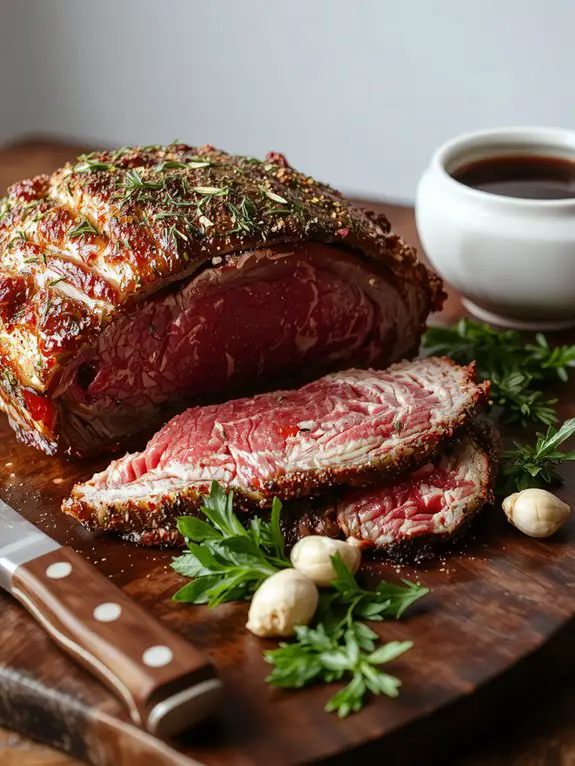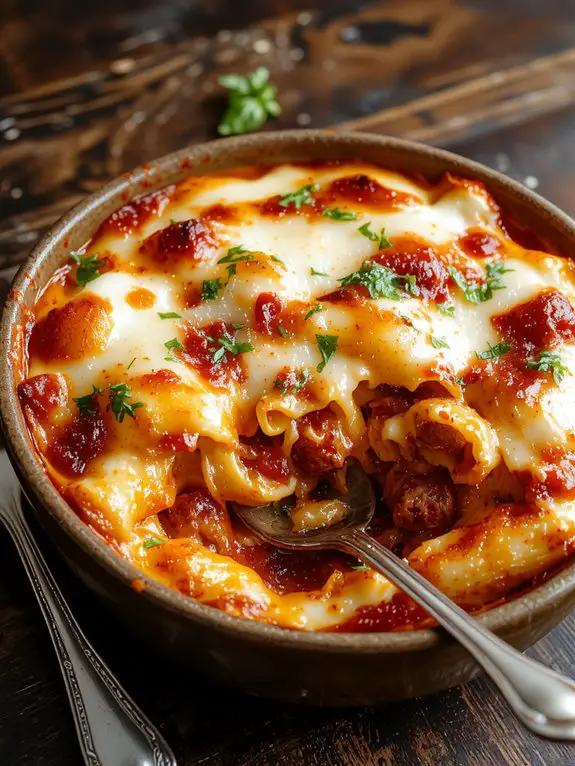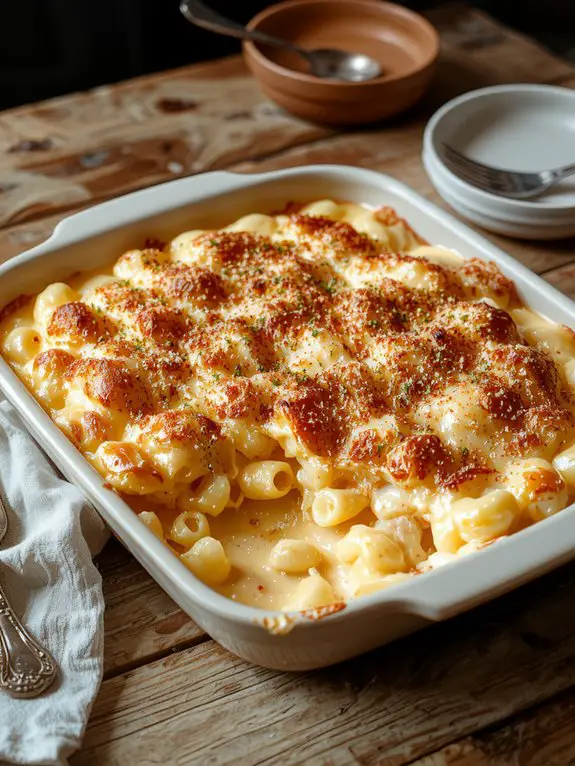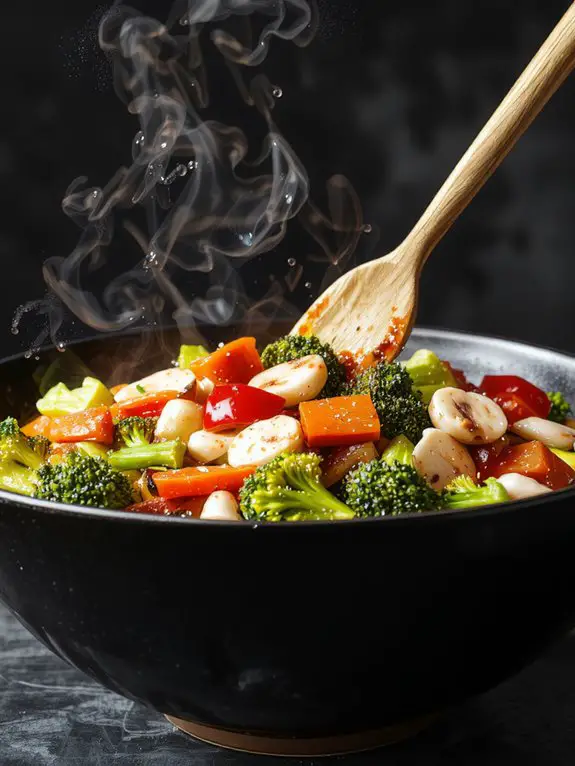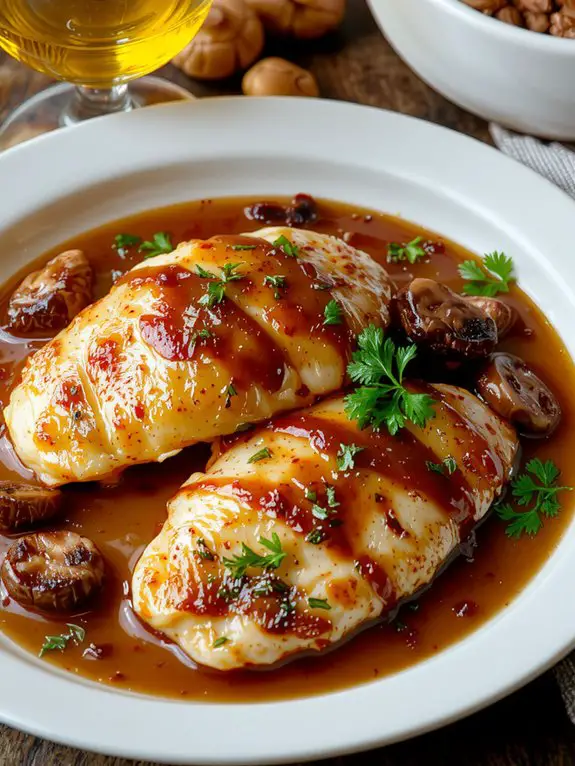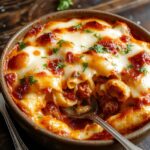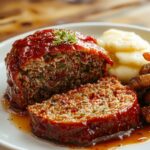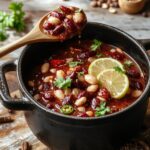I’ve been perfecting my prime rib technique for years, and there’s something deeply satisfying about nailing that perfect crust while keeping the interior beautifully pink. Most home cooks think it’s intimidating, but honestly, it’s more about understanding temperature control than any complex culinary magic. The real secret isn’t in expensive equipment or fancy seasonings—it’s in a simple adjustment that transforms good roast into something your guests won’t stop talking about.
Recipe
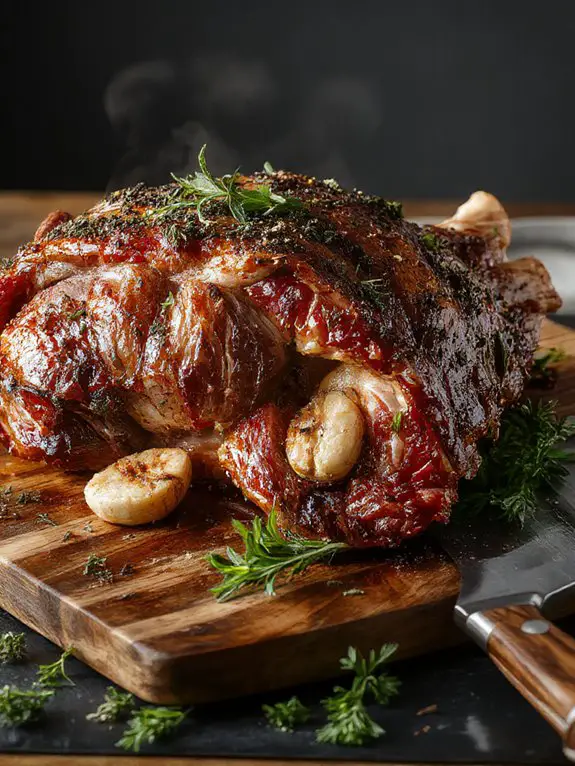
I can promise you with absolute certainty that this prime rib recipe will deliver the most show-stopping, melt-in-your-mouth roast you’ve ever made—one that’ll have your family and friends asking for your secret for years to come.
What makes this recipe truly extraordinary is the simple herb crust that forms a gorgeous, aromatic bark while keeping the interior impossibly tender and juicy, plus the reverse-sear method that guarantees perfect edge-to-edge doneness every single time.
I’ve been perfecting this technique for over a decade, and honestly, there’s nothing quite like the moment you slice into that beautiful roast and see that perfect pink center surrounded by that incredible seasoned crust—the aroma alone will fill your entire kitchen with the most intoxicating blend of garlic, fresh herbs, and rich, beefy goodness.
The exterior develops this amazing caramelized texture that gives way to butter-soft meat that practically falls apart with your fork, while the natural juices create their own incredible au jus.
Trust me when I say this isn’t just dinner—it’s an experience that turns any meal into a celebration, and even if you’ve never tackled a prime rib before, this foolproof method will have you cooking like a seasoned chef.
Ingredients
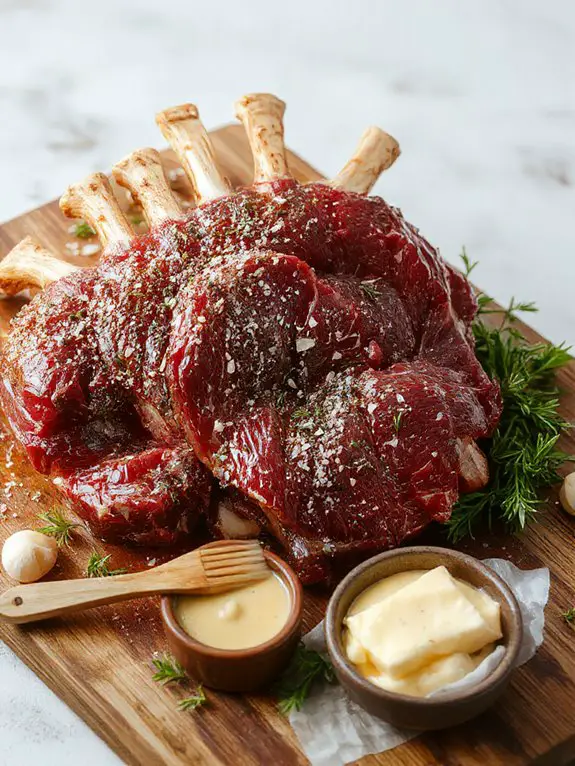
The secret to an unforgettable prime rib starts way before you even touch the oven—it’s all about selecting the right cut and building layers of flavor that’ll have your guests thinking you’ve been hiding culinary school training.
Here’s what separates the pros from the weekend warriors: quality ingredients and knowing exactly why each one matters.
The Star of the Show:
• Bone-in prime rib roast (3-7 ribs) – This is your non-negotiable centerpiece. The bones act as natural heat conductors and flavor amplifiers. Ask your butcher to French the bones for that restaurant-worthy presentation.
The Flavor Foundation:
- Kosher salt – Don’t even think about table salt here. Kosher salt’s larger crystals create the perfect crust and penetrate the meat beautifully. Diamond Crystal is the gold standard.
- Freshly cracked black pepper – Pre-ground pepper is flavor’s worst enemy. Crack it yourself for that aromatic punch that makes all the difference.
- Fresh garlic cloves – Paste from a jar won’t cut it. Fresh garlic creates those incredible aromatic pockets throughout the roast.
- Fresh rosemary sprigs – This herb was practically made for beef. Strip those needles and chop them fine for maximum impact.
- Fresh thyme leaves – The perfect herbal partner to rosemary. Together, they create an earthy, sophisticated flavor profile.
The Game-Changers:
- High-quality olive oil – This helps your seasoning stick and creates that golden, crackling exterior we’re all after.
- Dijon mustard – Here’s an insider secret: a thin layer of Dijon acts as both flavor enhancer and seasoning adhesive. Trust the process.
- Unsalted butter (room temperature) – For basting and creating that final glossy finish that screams restaurant quality.
Smart Substitutions:
If you can’t find fresh herbs, use half the amount of dried—but fresh really is worth the extra trip to the store. No Dijon? Whole grain mustard works, though you’ll lose some of that sharp bite that makes the flavor pop.
How to Make the Best Perfect Holiday Prime Rib
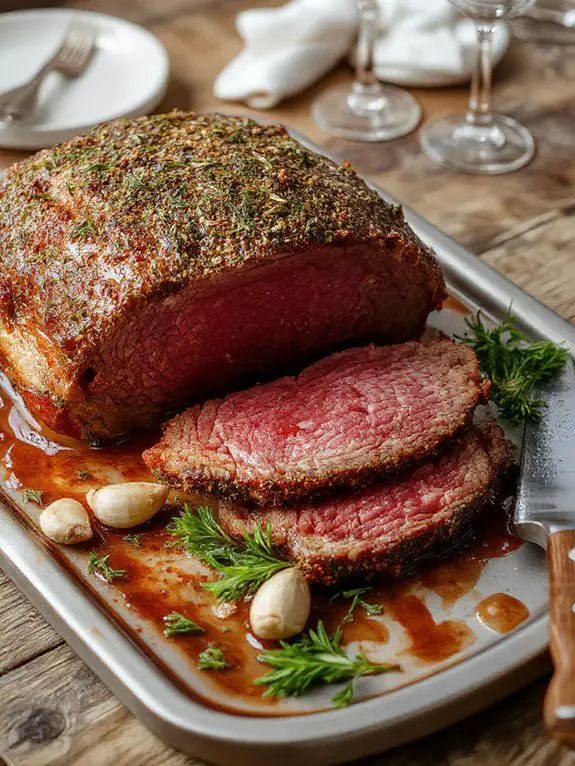
Let your prime rib come to room temperature for 2-3 hours before cooking.
This vital step guarantees even cooking throughout the roast. A cold roast straight from the fridge will cook unevenly, leaving you with overcooked edges and an undercooked center. Set it on the counter and resist the urge to rush this process—patience here pays off with perfectly uniform doneness.
Preheat your oven to 450°F and position the rack in the lower third.
The high initial heat creates that gorgeous golden-brown crust we’re after, while the lower rack position protects the top from burning during the long cooking process. Make sure your oven is fully preheated—this can take 20-30 minutes depending on your oven.
Pat the entire roast completely dry with paper towels.
Any surface moisture will create steam instead of the beautiful crust you want. Don’t skip this step! Even if you think it looks dry, give it another thorough pat. Dry surface equals better browning and that restaurant-quality appearance.
Generously season all surfaces with kosher salt, black pepper, and your chosen herbs.
Use about 1 tablespoon of salt per 3-4 pounds of meat—don’t be shy! The salt penetrates the meat and enhances flavor throughout.
Press the seasonings into the meat with your hands to help them adhere. Garlic powder, rosemary, and thyme are classic choices that complement beef beautifully.
Place the roast fat-side up on a roasting rack inside a heavy-bottomed pan.
The rack elevates the meat, allowing hot air to circulate underneath for even cooking. If you don’t have a rack, create one using thick celery stalks or carrots.
The fat cap on top naturally bastes the meat as it renders, keeping everything juicy.
Roast at 450°F for 15-20 minutes to develop the crust.
You’ll hear some sizzling and smell amazing aromas—this is exactly what you want! The high heat creates the Maillard reaction, developing those complex, savory flavors.
Don’t open the oven door during this vital browning phase.
Reduce temperature to 325°F without opening the oven door.
Simply turn down the heat and let the oven adjust. Opening the door releases valuable heat and can add 10-15 minutes to your cooking time.
The lower temperature gently finishes cooking the interior while maintaining that beautiful crust.
Insert a probe thermometer into the thickest part of the roast.
Aim for the center, avoiding any bones or fat pockets which can give false readings.
This is your best friend for perfect doneness—visual cues alone can be misleading with such a large roast. Position it so you can read it through the oven window.
Continue roasting until internal temperature reaches 10°F below your target.
For medium-rare, remove at 120°F; for medium, remove at 130°F. The temperature will continue rising during the resting period—this is called carryover cooking.
Removing it early prevents overcooking and guarantees your perfect doneness level.
Tent loosely with foil and rest for 20-30 minutes before carving.
Resting allows the juices to redistribute throughout the meat instead of running out onto your cutting board.
Don’t wrap tightly—you’ll steam that beautiful crust you worked so hard to create. Use this time to make gravy or finish side dishes.
Carve against the grain using a sharp carving knife.
Look for the direction of the muscle fibers and cut perpendicular to them.
This breaks up the fibers, making each slice incredibly tender. Slice about ½-inch thick for the perfect bite-sized portions that showcase your beautiful pink interior.
Chef Tips
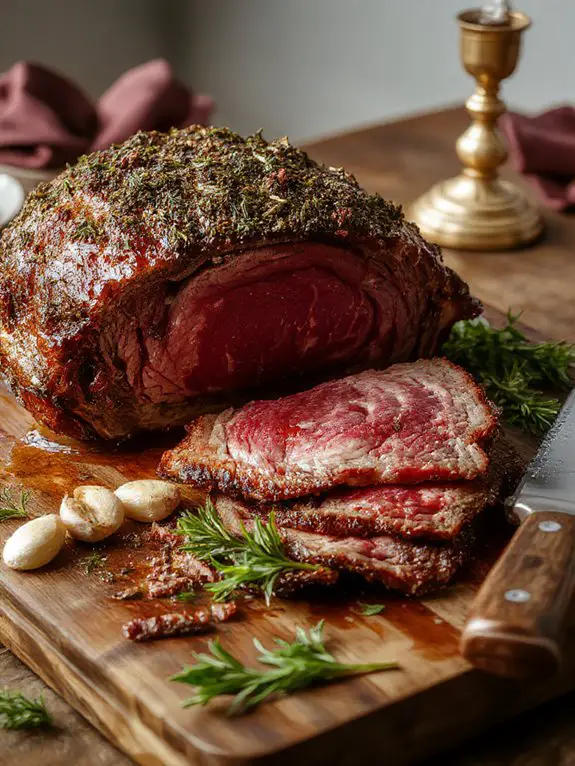
Mastery in prime rib cooking comes from understanding the subtle details that separate good from extraordinary.
I’ve learned that sharp knife skills guarantee clean, even slices that showcase the perfect gradient from crust to center.
Professional plating techniques involve warming plates beforehand and arranging slices to display that beautiful pink interior you’ve worked so hard to achieve.
Nutrition
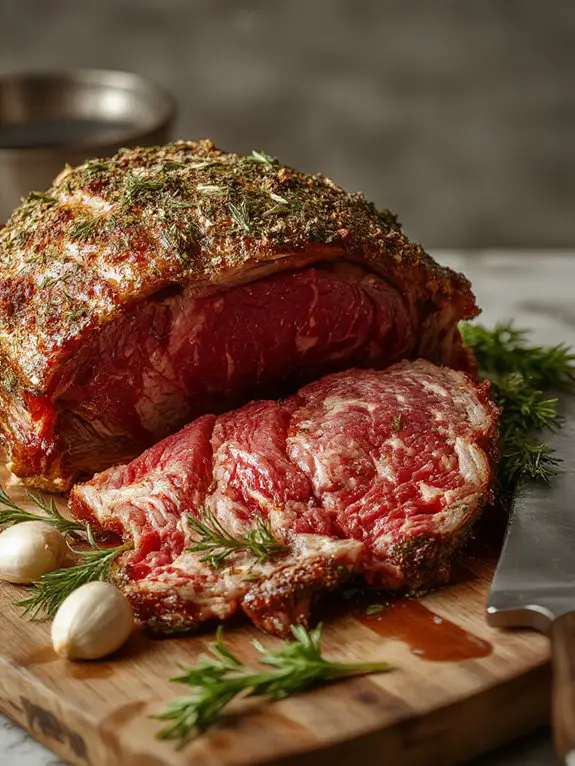
This prime rib recipe provides a rich source of high-quality protein and essential nutrients. A typical 6-ounce serving delivers substantial amounts of iron, zinc, and B vitamins while being naturally low in carbohydrates.
| Nutrient | Amount per 6 oz serving |
|---|---|
| Calories | 485 |
| Total Fat | 35g |
| Saturated Fat | 15g |
| Cholesterol | 140mg |
| Sodium | 95mg |
| Total Carbohydrates | 0g |
| Dietary Fiber | 0g |
| Sugars | 0g |
| Protein | 40g |
| Iron | 3.2mg |
| Zinc | 8.5mg |
| Vitamin B12 | 3.8mcg |
| Niacin | 7.2mg |
| Phosphorus | 285mg |
| Selenium | 32mcg |
What You’ll Love About This Recipe
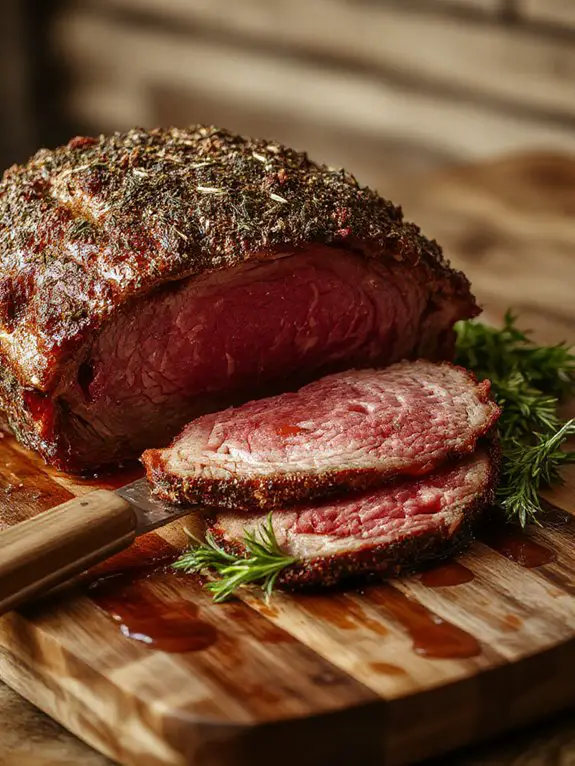
This prime rib recipe transforms your kitchen into a fine dining restaurant, and honestly, it’s way easier than you might think. You’ll feel like a total cooking rockstar when you pull this gorgeous roast out of the oven, and your family will be talking about it for months.
Perfect for special occasions without the stress – This recipe uses simple techniques that work every single time, so you can focus on enjoying your guests instead of worrying about whether dinner will turn out right.
Incredibly juicy and flavorful results – The slow roasting method keeps all those delicious juices locked in, while the herb crust adds amazing flavor that makes every bite absolutely incredible.
Feeds a crowd and looks impressive – One beautiful roast easily serves 6-8 people, and when you slice it at the table, everyone will think you’re some kind of culinary genius, even though it was surprisingly simple to make.
Recipe Card
This classic prime rib recipe delivers a perfectly seasoned, tender roast with a beautiful crust that’s ideal for special occasions and holiday gatherings. The simple seasoning blend allows the natural beef flavors to shine while creating an impressive centerpiece that feeds a crowd.
Ingredients:
- 1 (6-8 pound) bone-in prime rib roast
- 2 tablespoons kosher salt
- 1 tablespoon black pepper
- 1 tablespoon garlic powder
- 1 tablespoon dried rosemary
- 1 tablespoon dried thyme
- 2 tablespoons olive oil
Instructions:
- Remove prime rib from refrigerator 2 hours before cooking to bring to room temperature.
- Preheat oven to 450°F.
- Mix salt, pepper, garlic powder, rosemary, and thyme in a small bowl.
- Rub olive oil all over the roast, then coat evenly with seasoning mixture.
- Place roast bone-side down in roasting pan.
- Roast for 20 minutes, then reduce temperature to 325°F.
- Continue cooking until internal temperature reaches 120°F for rare, 130°F for medium-rare, or 140°F for medium.
- Remove from oven and tent with foil. Let rest 20 minutes before carving.
Notes:
Use a meat thermometer for accurate doneness. The internal temperature will rise 5-10 degrees during resting.
For best results, choose a roast with good marbling and have your butcher remove the chine bone for easier carving.
Equipment:
Roasting pan, meat thermometer, carving knife
Time:
Prep time: 15 minutes
Cooking time: 2-3 hours
Cuisine: American
Serving: 8-10 people

